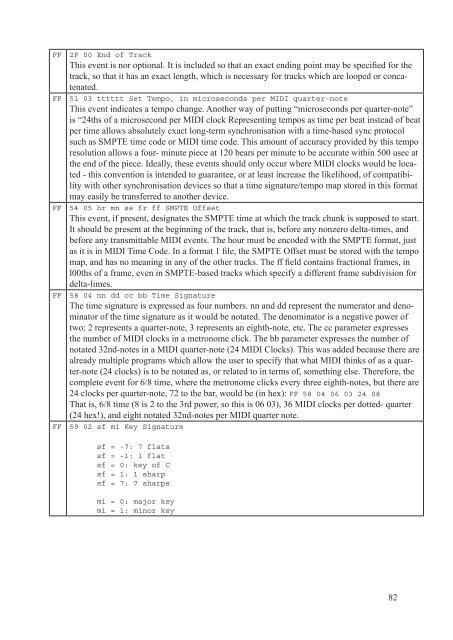2.3 Relaxatie-oscillator
2.3 Relaxatie-oscillator
2.3 Relaxatie-oscillator
You also want an ePaper? Increase the reach of your titles
YUMPU automatically turns print PDFs into web optimized ePapers that Google loves.
FF 2F 00 End of Track<br />
This event is nor optional. It is included so that an exact ending point may be specified for the<br />
track, so that it has an exact length, which is necessary for tracks which are looped or concatenated.<br />
FF 51 03 tttttt Set Tempo, in microseconds per MIDI quarter-note<br />
This event indicates a tempo change. Another way of putting “microseconds per quarter-note”<br />
is “24ths of a microsecond per MIDI clock Representing tempos as time per beat instead of beat<br />
per time allows absolutely exact long-term synchronisation with a time-based sync protocol<br />
such as SMPTE time code or MIDI time code. This amount of accuracy provided by this tempo<br />
resolution allows a four- minute piece at 120 bears per minute to be accurate within 500 usec at<br />
the end of the piece. Ideally, these events should only occur where MIDI clocks would be located<br />
- this convention is intended to guarantee, or at least increase the likelihood, of compatibility<br />
with other synchronisation devices so that a time signature/tempo map stored in this format<br />
may easily be transferred to another device.<br />
FF 54 05 hr mn se fr ff SMPTE Offset<br />
This event, if present, designates the SMPTE time at which the track chunk is supposed to start.<br />
It should be present at the beginning of the track, that is, before any nonzero delta-times, and<br />
before any transmittable MIDI events. The hour must be encoded with the SMPTE format, just<br />
as it is in MIDI Time Code. In a format 1 file, the SMPTE Offset must be stored with the tempo<br />
map, and has no meaning in any of the other tracks. The ff field contains fractional frames, in<br />
l00ths of a frame, even in SMPTE-based tracks which specify a different frame subdivision for<br />
delta-limes.<br />
FF 58 04 nn dd cc bb Time Signature<br />
The time signature is expressed as four numbers. nn and dd represent the numerator and denominator<br />
of the time signature as it would be notated. The denominator is a negative power of<br />
two: 2 represents a quarter-note, 3 represents an eighth-note, etc. The cc parameter expresses<br />
the number of MIDI clocks in a metronome click. The bb parameter expresses the number of<br />
notated 32nd-notes in a MIDI quarter-note (24 MIDI Clocks). This was added because there are<br />
already multiple programs which allow the user to specify that what MIDI thinks of as a quarter-note<br />
(24 clocks) is to be notated as, or related to in terms of, something else. Therefore, the<br />
complete event for 6/8 time, where the metronome clicks every three eighth-notes, but there are<br />
24 clocks per quarter-note, 72 to the bar, would be (in hex): FF 58 04 06 03 24 08<br />
That is, 6/8 time (8 is 2 to the 3rd power, so this is 06 03), 36 MIDI clocks per dotted- quarter<br />
(24 hex!), and eight notated 32nd-notes per MIDI quarter note.<br />
FF 59 02 sf mi Key Signature<br />
sf = -7: 7 flats<br />
sf = -1: 1 flat<br />
sf = 0: key of C<br />
sf = 1: 1 sharp<br />
sf = 7: 7 sharps<br />
mi = 0: major key<br />
mi = 1: minor key<br />
82


